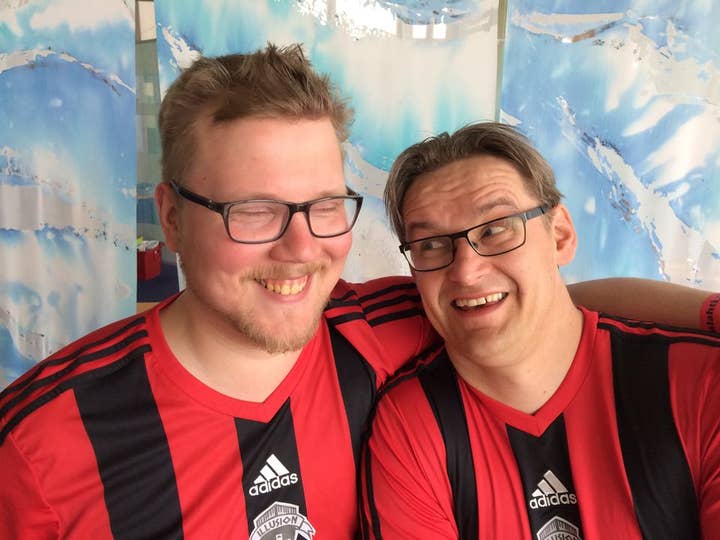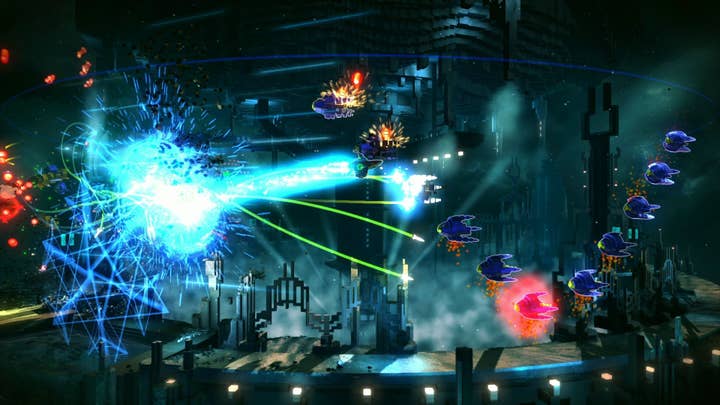"We see ourselves as the last Mohicans, the last dinosaurs"
After 20 years of Housemarque, is it time to reinvent or double down?
I can still remember my first games machine - a Spectrum+2. Bulky, ugly, grey, noisy. The key to infinite worlds. It came on a Christmas morning - my dad dressed up as Santa with a huge smile. I'd never even heard of it, but 20 minutes later I knew that it was everything I'd ever wanted. The first game I ever played on it? Eugene Jarvis' arcade classic Defender.
Defender was a landmark game. Even on the slow and unwieldy Speccy, it was quick and agile, brightly coloured and full of promise. There were no edges to the world, no boundaries to the experience other than the punishing difficulty. The addition of a 'hyperspace' button, which in reality just threw you randomly around the map, lent it an enthralling sense of infinity, leading to countless hours spent huddled in front of a tiny 14" CRT. Good times.

The legend of Jarvis himself is also writ large - renowned for boundless energy and party stamina which would test someone 40 years younger, Jarvis is one of early game dev's cult heroes. Although it's been a while since his last 'real' game, Jarvis now lives and works in Skokie, Illinois - a 'village' which forms part of the northern suburbs of Chicago. There, in his "Raw Thrills" factory and warehouse, he works on arcade cabinets, both new and old, for the likes of Dave and Buster's and Chuckie Cheese, a throwback to his early career as a pinball table creator for Midway and Atari. Now, he's back in the development trenches, thanks to a chance Las Vegas meeting with Finnish developer Housemarque.
The Helsinki team is a big fan. Raised on Jarvis' particular brand of fast, difficult and pure arcade games, the influence of titles like Defender and Robotron is clear to anyone who's enjoyed the games Housemarque has been making for the last two decades. Now, as Housemarque celebrates its 20th anniversary, they're working together with Jaarvis on a brand new project, as well as a feature length film celebrating both the collaboration and 20 years of game-making.
"When I saw Resogun I couldn't believe how these Housemarque guys took Defender to a new level. I wondered... what would happen if we teamed up? Mash up old school arcade with mad voxel tech and crazed nouveau Helsinki gamers... All I know now is that it is going to be explosive."
Eugene Jarvis
"We're on the same page," laughs Housemarque founder and CEO Illari Kuittinen when I ask him about working with one of his heroes. "His guidelines are usually 'more explosions'...We're there. We understand that shit."
"It's tougher than we thought," says a slightly more cautious Mikael Haveri, the team's ebullient head of self-publishing. "There's an ocean between us, literally! But the wow moments come from the little bits in conversation when you just see him light up, and this 62 year old living-legend just barrages you with all this information and it all makes sense. It's the small moments.
"One of the things that Eugene mentioned about Defender is that it had one of the best ever monetisation mechanics, because the game was so fucking difficult. People just kept pumping those quarters in. It's funny how many of these things sort of stem from the arcades: free to play, IAP, microtransactions, in a sense. Defender apparently made over a billion dollars. Four billion quarters."
The game, currently known only as "The Jarvis Project", has been kept very much under wraps so far, with the only hints being that it's very firmly in the traditional pedigree of Jarvis and Housemarque alike. (At the end of a presentation at Nordic Game in Malmo, Haveri and Kuittinen show a flash of a logo which has more than a touch of Robotron about it...) Nonetheless, it feels like a dream project for the company, a natural culmination of their championing of the genre for so long - a wonderful 20th anniversary present. But there are no illusions amongst the team about it ushering in a new era for the sort of games they make.
"Yeah, it's been a great year," says Kuittinen, when I remark on the renaissance which Housemarque has experienced of late. "It's been brilliant to be able to release Resogun and Alienation with the backing of Sony...but without that it probably wouldn't have been possible - looking at those games as commercial propositions, you probably wouldn't normally put so much money and effort behind them. So, in a way, we see ourselves as the last Mohicans, the last dinosaurs. Who knows, Alienation might be the last of it's kind, in some senses."

"Resogun is a good example," agrees Haveri, "because when you think of who might publish something like that, you're thinking Japanese. Maybe Sega could throw a bit of money that way, but it's a dying breed. With Alienation we did a bit more with light RPG elements, team co-op. In a sense it's Helldivers with Diablo. So there's a market for these kinds of things. But again, the $20 price point is something a bit different. If it's Blizzard making Diablo 4, I'm sure there's a market, but if it's a $20 Diablo with guns sci-fi thing...That's still pretty niche.
"To summarise that point, we're comfortable and we love what we do, but is it the future of gaming? Is the growth potential there? That's something we're always pondering."
"Is there actually a market there? You want to focus on creating those awesome titles, those values we want to uphold, but in the end are we going to be able to get our bills paid?"
So is the Jarvis project, and attendant documentary "The Name of the Game" a reaffirmation of Housemarque's pedigree, and a forward looking manifesto to boot, or a memorial to an era which must surely come to pass?
"I guess The Jarvis Project is that sort of a thing, I suppose," says Kuittinen. "We get to self publish it, we get to do one more thing, at least with the resources we have...but whether there's a big enough audience for that, we don't know. We know there's a core audience which loves it, but we don't know if they're big enough to make the next game viable. We're grateful that we've got to make games like Resogun, nobody else has been able to do that. But there's a reason for that, and it's not that they make too much money."
"In the end it comes down to the fact that, as we have this dream of bringing arcade back, why hasn't anyone else done it yet," Hivari agrees. "Is there actually a market there? You want to focus on creating those awesome titles, those values we want to uphold, but in the end are we going to be able to get our bills paid?"
It's a frank question. Whilst Jarvis' name is written in lights for many of his fans, they're not exactly representative of the game buying public. There's obviously something of a promotional element to the film, too, but it's not a bullet-proof marketing plan. How do you sell a niche game in a marketplace where even the biggest names struggle to get noticed?

"Hopefully the Jarvis project is interesting," says Kuittinen, more brightly. "There's a good reason we're doing it, there's a good story there. But it's how to get that story in front of as many people as possible, that's the challenge for us now. These days, when you need to pay a YouTuber tens of thousands to play your game...that makes it incredibly challenging for little guys. YouTubers are definitely here to stay, the problem from our perspective is finding the ones that are actually interested in this kind of game. It's kind of a dying breed."
"To me, YouTube is like the Gutenberg press," adds Haveri. "It was like a wildfire. Suddenly everyone is saying, "oh shit, let me play Angry Birds and put it on the internet." But you don't know the quality. Eventually the good stuff tends to come out on top, but there's so much content.
"In terms of where we want to go...I don't know. We definitely want to make games that are appealing to the people who make this sort of content, whether that's on YouTube or Twitch, and they're very different beasts, but also to journalists and competitive players. If we can show it to those players, and competitive play design comes naturally to us, then maybe they want to play it on Twitch or YouTube. I think that's our way, rather than calling up the big agencies."










